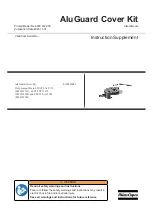
SAFETY
-6-
Additional Safety Instructions For Jointers
Use this and other machinery with caution
and respect. Always consider safety first, as
it applies to your individual working condi-
tions. No list of safety guidelines can be com-
plete—every shop environment is different.
Failure to follow guidelines could result in
serious personal injury, damage to equip-
ment or poor work results.
1.
JOINTING SAFETY BEGINS WITH YOUR LUMBER.
Inspect your stock carefully before you feed it over
the cutterhead. If you have any doubts about the stability or structural integrity of your stock, DO
NOT JOINT IT! Unstable workpieces can result in kickback.
2.
MAINTAIN THE PROPER ALIGNMENT
of the outfeed table with the cutterhead knife.
3.
ALWAYS USE PUSH BLOCKS WHEN JOINTING.
Never allow your hands to get near the cutterhead.
4.
SUPPORT AND MAINTAIN CONTROL OVER THE WORKPIECE
at all times during operation.
5.
WHEN JOINTING, DO NOT STAND DIRECTLY BEHIND THE WORKPIECE.
Position yourself just to the
side of the infeed table to avoid possible kickbacks.
6.
NEVER MAKE CUTS
deeper than
1
⁄
8
".
7.
NEVER JOINT A BOARD THAT HAS LOOSE KNOTS, NAILS, STAPLES, OR EMBEDDED DIRT/STONES.
All defects and foreign objects should be removed before use.
8.
NEVER JOINT END GRAIN.
9.
WITH THE EXCEPTION OF RABBETING,
all operations must be performed with the guard in place.
After rabbeting, be sure to replace the guard.
10. NEVER CHANGE FEEDING DIRECTIONS DURING A CUT
. Any time the workpiece moves backwards,
the chances of kickback and injury are greatly increased.
11. “KICKBACK”
is when the workpiece is thrown off the jointer table by the force of the cutterhead.
Always use push blocks and safety glasses to reduce the likelihood of injury from “kickback.” If you
do not understand what kickback is, or how it occurs, DO NOT operate this machine.
12. BE AWARE THAT CERTAIN WOODS MAY CAUSE AN ALLERGIC REACTION
in people and animals,
especially when exposed to fine dust. Make sure you know what type of wood dust you will be
exposed to and always wear an approved respirator.
Read and understand this
entire instruction manual
before performing any
operations with your
machine. Serious personal
injury may occur if safety
and operational informa-
tion is not understood and
is not followed. Do not risk
your safety by not read-
ing!









































